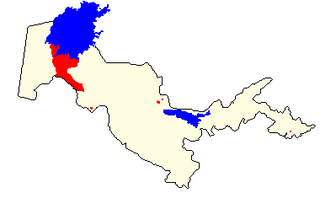

| Karakalpak | |
|---|---|
| Qaraqalpaq tili, Қарақалпақ тили, قاراقالپاق تىلى | |
| Native to | Uzbekistan, Kazakhstan, Turkmenistan |
| Region | Karakalpakstan |
Native speakers | 583,410 (2010)[1] |
| Official status | |
Official language in | |
| Language codes | |
| ISO 639-2 | kaa |
| ISO 639-3 | kaa |
| Glottolog | kara1467 |
 Map showing locations of Karakalpak (red) within Uzbekistan | |
| This article contains IPA phonetic symbols. Without proper rendering support, you may see question marks, boxes, or other symbols instead of Unicode characters. For an introductory guide on IPA symbols, see Help:IPA. | |
Karakalpak is a Turkic language spoken by KarakalpaksinKarakalpakstan. It is divided into two dialects, Northeastern Karakalpak and Southeastern Karakalpak. It developed alongside neighboring Kazakh and Uzbek languages, being markedly influnced by both. Typologically, Karakalpak belongs to the Kipchak branch of the Turkic languages, thus being closely related to and partially mutually intelligible to Kazakh.[3]
Karakalpak is a member of the Kipchak branch of Turkic languages, which includes Tatar, Kumyk, Nogai, and Kazakh. Due to its proximity to Uzbek, much of Karakalpak's vocabulary and grammar has been influenced by Uzbek. Like Turkish, Karakalpak has vowel harmony, is agglutinative and has no grammatical gender. Word order is usually subject–object–verb.
Karakalpak is spoken mainly in the Karakalpakstan Autonomous Republic of Uzbekistan. Approximately 2,000 people in Afghanistan and smaller diaspora in parts of Russia, Kazakhstan, Turkey, and other parts of the world speak Karakalpak.
Karakalpak has official status in the Karakalpakstan Autonomous Republic.
The Ethnologue identifies two dialects of Karakalpak: Northeastern and Southwestern. Menges mentions a third possible dialect spoken in the Fergana Valley. The Southwestern dialect has /tʃ/ for the Northeastern /ʃ/.
Karakalpak has 21 native consonant phonemes and regularly uses four non-native phonemes in loan words. Non-native sounds are shown in parentheses.

| Labial | Labiodental | Alveolar | Palatal | Velar | Uvular | Glottal | ||
|---|---|---|---|---|---|---|---|---|
| Nasal | m | n | ŋ | |||||
| Stop | voiceless | p | t | k | q | |||
| voiced | b | d | g | |||||
| Affricate | (t͡s) | (t͡ʃ) | ||||||
| Fricative | voiceless | (f) | s | ʃ | x | h | ||
| voiced | (v) | z | ʒ | ɣ | ||||
| Trill | r | |||||||
| Approximant | l | j | w | |||||
Vowel harmony functions in Karakalpak much as it does in other Turkic languages. Words borrowed from Russian or other languages may not observe rules of vowel harmony, but the following rules usually apply:
| Vowel | May be followed by: |
|---|---|
| a | a, ɯ |
| æ | e, i |
| e | e, i |
| i | e, i |
| o | a, o, u, ɯ |
| œ | e, i, œ, y |
| u | a, o, u |
| y | e, œ, y |
| ɯ | a, ɯ |
men I, sen you (singular), ol he, she, it, that, biz we, siz you (plural), olar they
bir 1, eki 2, úsh 3, tórt 4, bes 5, altı 6, jeti 7, segiz 8, toǵıs 9, on 10, júz 100, mın' 1000


Karakalpak was written in the Arabic and Persian script until 1928, in the Latin script (with additional characters) from 1928 to 1940, after which Cyrillic was introduced. Following Uzbekistan's independence in 1991, the decision was made to drop Cyrillic and revert to the Latin alphabet. Whilst the use of Latin script is now widespread in Tashkent, its introduction into Karakalpakstan remains gradual. The Cyrillic and Latin alphabets are shown below with their equivalent representations in the IPA. Cyrillic letters with no representation in the Latin alphabet are marked with asterisks. The last changes to the new Karakalpak alphabet were made in 2016: instead of letters with apostrophes, letters with acutes were introduced.[citation needed]
| Cyrillic | Latin | IPA | Cyrillic | Latin | IPA | Cyrillic | Latin | IPA | ||
|---|---|---|---|---|---|---|---|---|---|---|
| Аа | Aa | /a/ | Ққ | /q/ | Фф | Ff | /f/ | |||
| Әә | Áá | /æ/ | Лл | Ll | /l/ | Хх | Xx | /x/ | ||
| Бб | Bb | /b/ | Мм | Mm | /m/ | Ҳҳ | Hh | /h/ | ||
| Вв | Vv | /v/ | Нн | Nn | /n/ | Цц | Cc | /ts/ | ||
| Гг | Gg | /ɡ/ | Ңң | Ńń | /ŋ/ | Чч | CHch | /tʃ/ | ||
| Ғғ | Ǵǵ | /ɣ/ | Оо | Oo | /o/ | Шш | SHsh | /ʃ/ | ||
| Дд | Dd | /d/ | Өө | Óó | /œ/ | Щщ* | sh | /ʃ/ | ||
| Ее | Ee | /e/ | Пп | Pp | /p/ | Ъъ* | ||||
| Ёё* | yo | /jo/ | Рр | Rr | /r/ | Ыы | Íı | /ɯ/ | ||
| Жж | Jj | /ʒ/ | Сс | Ss | /s/ | Ьь* | ||||
| Зз | Zz | /z/ | Тт | Tt | /t/ | Ээ | Ee | /e/ | ||
| Ии | Ii | /i/ | Уу | Uu | /u/ | Юю* | yu | /ju/ | ||
| Йй | Yy | /j/ | Үү | Úú | /y/ | Яя | ya | /ja/ | ||
| Кк | Kk | /k/ | Ўў | Ww | /w/ |
Before 2009, C was written as TS; I and I' were written as dotted and dotless I.[4]
Glottolog was invoked but never defined (see the help page).|
| |||||||||||||||||||||||||||||||||||||||||||||
|---|---|---|---|---|---|---|---|---|---|---|---|---|---|---|---|---|---|---|---|---|---|---|---|---|---|---|---|---|---|---|---|---|---|---|---|---|---|---|---|---|---|---|---|---|---|
| Proto-language |
| ||||||||||||||||||||||||||||||||||||||||||||
| Common Turkic |
| ||||||||||||||||||||||||||||||||||||||||||||
| Oghur |
| ||||||||||||||||||||||||||||||||||||||||||||
| Disputed classification |
| ||||||||||||||||||||||||||||||||||||||||||||
| Creoles and pidgins |
| ||||||||||||||||||||||||||||||||||||||||||||
| |||||||||||||||||||||||||||||||||||||||||||||